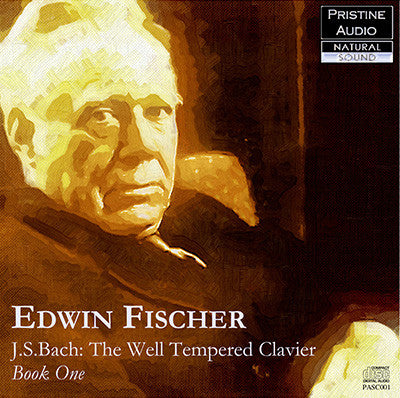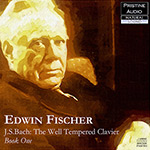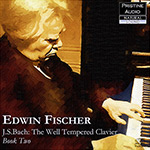
This album is included in the following sets:
This set contains the following albums:
- Producer's Note
- Cover Art
Edwin Fischer's classic world's-first recording of Das wohltemperierte Klavier
The recording that inspired the creation of Pristine Classical
Twenty years after the commencement of this monumental recording,
Sackville-West and Shawe-Taylor, noting that this was still the only
recording available in England of Bach's epic 48 Preludes and Fugues,
delighted in Edwin Fischer's achievement: "quiet, self-possessed,
beautifully sensitive to the great variety of moods in this long chain
of masterpieces."
Their chief worry, that "the recording...is a
little dim by modern standards", needs no longer concern the modern
listener - these new restorations really do take the breath away and
reveal the true mastery of these recordings.
Gone is the dull
and, frankly, bizarre piano tone of certain other audio restorations of
this recording. Here is the sound of a piano being played gorgeously by
one of the 20th century's greatest pianists, in a seminal recording
which still stands as the benchmark for interpreters of Bach the world
over.
Andrew Rose
Bill Rosen's Review
Bach’s Well-Tempered Clavier (WTC) is not a great
piece of music like the “Eroica” symphony or “The Rite of Spring”.
Rather, it is a musical window on the pulsating field of energy which
surrounds us and which we perceive as the Universe. Andrew Rose of
Pristine Audio, by dint of enormous labor and artistry, has rescued this
historical performance, previously comfortably residing in the EMI
House of the Dead, and given it the breath of life to bring us its
meaning for today’s world. It reveals Edwin Fischer as a brilliant,
virile, imaginative pianist fully equal to all the challanges of the
Well-Tempered Clavier.
While listening to this work, I enjoyed
the thought that so many great musicians have experienced the same music
I was hearing. Beethoven was introduced to the work at age ten by his
teacher and began his teenage day by playing several preludes and
fugues. Beethoven said in later years, “it is far more than just a brook
(German: Bach); it is an ocean”. Mozart studied the WTC sufficiently to
write new preludes for six of the fugues; one wonders why? Both
Shostakovich and Rodion Shchedrin were inspired to write their own
canonical 24.
The recordings available of the Well Tempered
Clavier are without number. In my own collection, they range from
Mieszeslav Horzowski, who recorded a few preludes and fugues at his
100th birthday concert to Albert Wong, who recorded all of Book II at
the age of 10 and also wrote the program notes. I never considered Edwin
Fischer more than an “historically important” pianist. I respected him
for his Bach concerti, for his Beethoven “Emperor” Concerto with
Furtwangler and for being the first pianist to record Bach’s WTC. I can
now say that, as a result of listening to Pristine Audio’s restoration,
that judgment is completely wrong. Edwin Fischer is a great pianist, one
of the greatest pianists of the first half of the 20th century. His
recording of the Bach WTC can be matched by few of the many pianists or
harpsichordists of the post World-War II period. I know that this is a
lot to claim; I shall try to substantiate it in the paragraphs that
follow.
It is often said that keyboard technique improved
greatly after WWII and that some of the greats of the past could be
outplayed by today’s 13-year-old girl piano student (e.g. Cortot,
Gieseking). Not so Fischer—listen to his technique in Book 1: IX, XV;
Book II: VI, XX. Unlike Glen Gould, his technique does not dazzle and is
never obtrusive, but is always in the service of the music.
The
incredible variety of color with which Fischer invests the preludes is
to me unmatched: playful, innocent, laughing, pouting, sad, and on and
on. There are few tempo or dynamic markings and here Fischer’s great
European tradition really shows in the confident and daring range of his
choices, in his lack of fear and trembling before one of the great
edifices of European culture.
Counterpoint is good for us, we
are told. We are to follow it and appreciate it. Fischer shows us that
voices, entries, counter-subjects and stretti don’t matter. He plays the
music and a fugue as simply an essay in inevitability—always alive,
always forward moving. Listen to Book 1: VIII; Book 2: V, XIII, XXII.
There
is an occasional failure. Book 1: XXIV is the worst. The grief-stricken
B minor prelude has a moving base with a contrapuntally dissonant
two-part treble reminiscent of the opening chorus of the “St John
Passion”. Bach indicates that each part is to be repeated. Fischer does
not take the repeats. The fugue is marked Largo. Fischer plays it more
like an Andante, robbing it of its burden of grief. A rare failure in a
great performance.
One must sum up by saying that a great
restoration job has made it possible to hear a revelatory performance.
When I hear Gould perform these works, I think, “How great a pianist
Gould is or sometimes how great Bach is”. When I hear this Fischer
performance, I think how happy I am to be alive.
Reviewer: Bill Rosen


